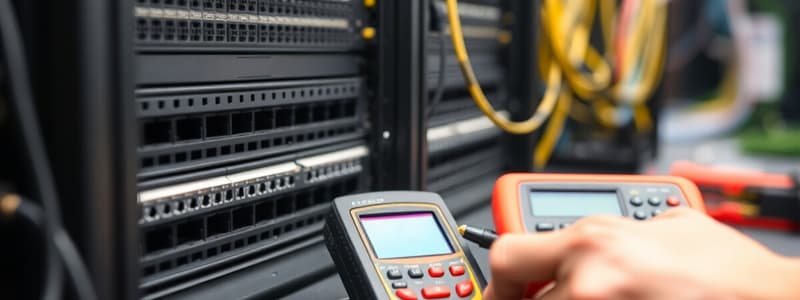Podcast
Questions and Answers
What tool would you use to attach connectors to the ends of cables?
What tool would you use to attach connectors to the ends of cables?
- Cable Strippers
- Cable Testers
- Multimeters
- Cable Crimpers (correct)
Which type of cable fault occurs when conductors of a wire pair are connected to each other at any point in the cable?
Which type of cable fault occurs when conductors of a wire pair are connected to each other at any point in the cable?
- Shorted Pair (correct)
- Reverse Pair
- Split Pair
- Open Pair
Which device is primarily used to generate tones in a cable for tracing?
Which device is primarily used to generate tones in a cable for tracing?
- Tone Generators/Toner Probe (correct)
- Cable Certifiers
- Optical Time Domain Reflectometers
- Fusion Splicers
What is the function of a multimeter in relation to copper cables?
What is the function of a multimeter in relation to copper cables?
What is the purpose of a loopback adapter in networking?
What is the purpose of a loopback adapter in networking?
Which tool would you use to determine cable category and data throughput?
Which tool would you use to determine cable category and data throughput?
What type of cable fault is indicated when a wire from one pair crosses into an adjacent pair?
What type of cable fault is indicated when a wire from one pair crosses into an adjacent pair?
Which tool is used for both measuring the signal amplitude and frequency variations within a spectrum?
Which tool is used for both measuring the signal amplitude and frequency variations within a spectrum?
What device would you use to locate breaks in fiber optic cables and measure signal loss?
What device would you use to locate breaks in fiber optic cables and measure signal loss?
What occurs when one or more conductors in a twisted pair cable are not connected on one of the pins?
What occurs when one or more conductors in a twisted pair cable are not connected on one of the pins?
Flashcards
Cable Stripper
Cable Stripper
A tool used to remove the outer jacket and insulation from cables, preparing them for connector attachment.
Cable Crimper
Cable Crimper
A tool that attaches connectors to the ends of cables, ensuring a secure connection.
Cable Tester
Cable Tester
A tool that verifies the continuity and correct pin configuration of cables, ensuring no breaks or miswires.
Open Pair
Open Pair
Signup and view all the flashcards
Shorted Pair
Shorted Pair
Signup and view all the flashcards
Short Between the Pairs
Short Between the Pairs
Signup and view all the flashcards
Reverse Pair
Reverse Pair
Signup and view all the flashcards
Cross Pair
Cross Pair
Signup and view all the flashcards
Cable Certifier
Cable Certifier
Signup and view all the flashcards
Loopback Adapter
Loopback Adapter
Signup and view all the flashcards
Study Notes
Hardware Tools for Network Troubleshooting
- Snips and Cutters: Used to cut cables from larger spools.
- Cable Strippers: Remove outer jacket and insulation from cables for connection.
- Cable Crimpers: Attach connectors to cable ends.
- Cable Testers: Verify continuity and proper pinouts, checking for breaks in cables. Multitesters support various cables and connectors for testing.
- Wire Maps: Work similarly to cable testers, diagnosing issues in twisted pair Ethernet cables.
- Open Pair: Occurs when conductors in a pair are not connected at either end.
- Shorted Pair: Conductors of a wire pair are connected internally.
- Short Between Pairs: Conductors of different pairs are connected internally.
- Reverse Pair: Wires in a single pair are connected to the opposite pins on the other end.
- Cross Pair: Wires of one color pair are connected to the pins of a different color pair.
- Split Pair: A wire from one pair is split and connects with an adjacent pair.
- Cable Certifiers: Determine cable category, data throughput, length, and other cable characteristics.
- Multimeters: Check voltage, amperage, and resistance of copper cables.
- Punchdown Tools: Terminate wires on punchdown blocks and strip excess insulation.
- Tone Generators/Toner Probe: Generate tones on one end of a connection for cable tracing, aiding in understanding cable paths in walls.
- Loopback Adapters: Create a loopback for testing connectivity (Ethernet and Fiber).
- Time Domain Reflectometers (TDR): Locate breaks in copper cables, and estimate distance.
- Optical Time Domain Reflectometers (OTDR): Locate breaks in fiber optic cables and measure signal loss.
- Fiber Light Meters: Measure attenuation in fiber optic cables. Multimode fiber uses LED; Single mode uses laser.
- Fusion Splicers: Permanently join fiber optic cables.
- TAPs (Taps): Copy or split packets for analysis, security, or network management.
- Spectrum Analyzers: Measure signal amplitude and frequency variation. (x-axis: frequency, y-axis: amplitude).
Choosing the Right Tool
- Understand which tool is suitable for troubleshooting specific cable types and issues.
Studying That Suits You
Use AI to generate personalized quizzes and flashcards to suit your learning preferences.




